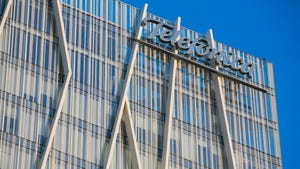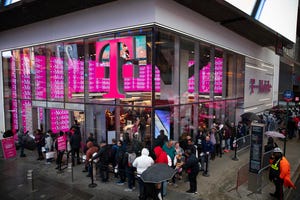Riverstone Fuels 10GigE Price War
Launches switch offering full line-rate performance at $10,000 a port, denting Cisco's cost-cutting claims
April 7, 2003

Riverstone Networks Inc. (Nasdaq: RSTN) challenged Cisco Systems Inc. (Nasdaq: CSCO) to a 10-Gbit/s Ethernet pricing war today with the announcement of its new 10-Gbit/s XGS switching platform that it claims takes the lead in both price and performance.
Cisco just announced its 10-Gbit/s Ethernet solution, enhancements to its Catalyst 6500, last week (see Cisco Takes On 10 GigE Competition). At the time, Cisco said it was the best the industry had seen in terms of price and performance. Now, Riverstone is upping the ante.
Riverstone claims that its XGS can provide true line-rate packet forwarding at 10 Gbit/s for roughly $10,000 per port. Cisco claims an even lower price per port -- about $6,300 -- but that's with a catch. Cisco admits that the four-port module used to get this pricing doesn’t perform at line rate. Its two-port module, which does perform at line rate, costs about $23,800 per port.
Essentially, both Cisco and Riverstone recognize that there are two distinct markets for 10-Gbit/s Ethernet technology. There are the high-end users such as research facilities and metro providers that need full 10-Gig line-rate performance. Then there are the enterprise customers that would like to take advantage of cheap 1-Gbit/s Ethernet to the desktop. As that rolls out, these customers will need a 10-Gbit/s switch to aggregate that traffic.
“In an over-subscribed wiring closet there’s no way we are going to get people to move away from their Catalyst 6500s,” says Steven Garrison, director of marketing for Riverstone. “We are okay with that. We’re going after the high-end market, where folks need wire-rate performance.”Table 1: 10-Gbit/s Ethernet Per Port Pricing
Line Card Density | Cisco | Extreme | Force10 | Foundry | Riverstone |
1-port 10 GigE | $58,200 | $24,250 | Not available | $38,500 | $9,995 |
2-port 10 GigE | $23,800 | Not announced | $17,000 | $26,950 | Not announced |
4-port 10 GigE | $6,300 | Not announced | Not announced | Not announced | Not announced |
|
Compared to the competition, Cisco’s $23,800 a port still sounds impressive. As you can see from the chart above, Cisco is in line with competitors, Force10 Networks Inc. and Foundry Networks Inc. (Nasdaq: FDRY), the only other two companies offering two-port 10-Gbit/s line cards. Force10, which also claims full line-rate performance, comes in at about $17,000 per port. But it is a startup, and, although the company just closed another round of funding, some customers are a bit chary as to whether it will survive (see Force10 Rakes In $41M ).
Foundry is priced slightly above Cisco’s two-port module at roughly $26,950 per port (see Foundry Intros Next-Gen 10-Gig Ethernet ). But, like Cisco’s four-port module, Foundry doesn’t perform at line rate. The company is expected to announce its next-generation 10-Gbit/s platform -- code named Mucho Grande -- which is expected to perform at line rate, later this spring. Extreme Networks Inc. (Nasdaq: EXTR) offers a one-port 10-Gbit/s line card for its switches. It too is limited in performance by its architecture. Extreme is also expected to announce a new platform this spring or summer.
There’s no question that the 10-Gig sector is becoming crowded. But it’s still too early to tell how much the market is actually worth. According to Zeus Kerravala, an analyst with Yankee Group, the total market for 10-Gbit/s Ethernet in 2002 was $120 million. He predicted in a report published last fall that the market would grow to $800 million in 2003 and $4 billion by 2006. But now, he says, these projections have most likely changed.
“The pricing has fallen a lot quicker than I thought it would,” he says. “I thought per-port pricing would get to about $15,000 by the end of 2003. And now we’re seeing $10,000 per port.”
The discussion of price and performance for 10-Gbit/s Ethernet is critical. Customers looking for such technology say that is one of their biggest hurdles.
“Wonderful technology is good, but only if you can afford it,” says Jack Costanza, technology manager for the artificial intelligence lab at Massachusetts Institute of Technology (MIT), which is testing the Riverstone XGS platform. “We don’t want free or low-cost junk, but pricing is a major part of trying to make the decision.”
Costanza says MIT hopes to use the Riverstone switches in a production network to run high-end data models and experiments. It will also use the gear to provide massive amounts of bandwidth to a LAN serving administrators and students. He evaluated gear from Cisco, Extreme, and Force10, as well. Foundry pulled out of the bidding process early, he says. His team selected Riverstone not just for price, but also for its performance and features.
The XGS comes in two sizes: XGS 9016 and XGS 9008. The XGS 9016 is a 16-slot chassis that sits in half a 7-foot telecom rack. It has 320 Gbit/s of capacity with a sustained throughput of 400 million packets per second. The company says a second fabric can be added to increase the capacity to 640 Gbit/s and throughput of 800 million pps. The smaller version, XGS 9008, is an eight-slot chassis with 160 Gbit/s worth of capacity and throughput of 200 million pps. This is also upgradeable.
Aside from price and performance, the XGS platform provides a high level of reliability. It comes equipped with redundant switch fabrics and central processor units. And for the first time on a Riverstone box, the software code is modular. This allows customers to more efficiently troubleshoot problems and load software patches.
— Marguerite Reardon, Senior Editor, Light Reading
You May Also Like









